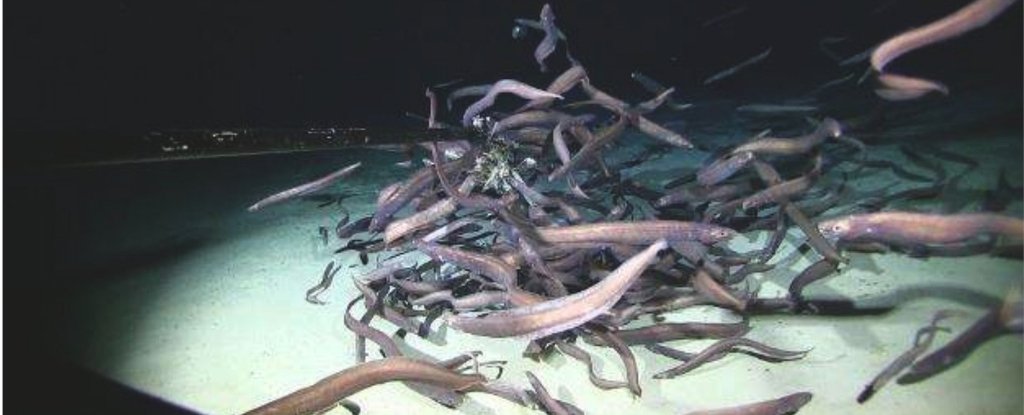
Before we start mining for precious metals in the darkness of the deep sea, we might try switching on the light first and observing our surroundings.
In this seemingly isolated abyss, at deeper than 3,000 metres (9,800 ft) below sea level, scientists were able to coax a massive swarm of 115 cutthroat eels (Ilyophis arx) out of the shadows and into the light, and with only a relatively small package of bait.
The footage represents the greatest number of deep sea fish ever recorded at one time in the abyssal ocean, and it was shot right near an international mining hotspot.
"Our observations truly surprised us," says biological oceanographer Astrid Leitner, who worked on the research at the University of Hawai'i at Mānoa.
"We had never seen reports of such high numbers of fishes in the sparsely-populated, food-limited deep-sea."
The Clarion-Clipperton Zone (CCZ) is a massive expanse of seafloor that runs from Hawaii nearly to Mexico, and it contains some of the rarest and most highly demanded metals and elements on our planet.
Over the years, it's drawn increasing interest from the mining industry, which sees this new region as a way to cut down on human labour and the destruction of precious land.
Sixteen contracts have already been issued for deep sea mining in more than 1 million square kilometres of this zone, and yet only a tiny portion of deep abyssal habitats have been sampled, explored, or even mapped by scientists.
It's decisions like this that have some scientists and environmentalists warning of a deep sea "gold rush" that could cause unforeseen damage to ecosystems we know very little about.
The abyssal plains that blanket the bottom of our oceans represent 70 percent of our planet's seafloor and are considered the largest ecosystem on Earth.
But while these depths are generally thought to contain sparse life, with particularly few fish, that generalisation might not apply to all the underwater mountain ranges – called seamounts – that border these valleys, emerging from the surrounding abyssal plain.
Recent expeditions among submerged seamounts in the Galapagos and off the coast of Tasmania have revealed an unexpected abundance of life forms, many of which we've never seen before, and some dwell on these submerged summits that are still deep enough to be considered 'abyssal'.
To figure out what's down there before we start unearthing sediment and spreading plumes of material kilometres away, an expedition of ocean scientists set out for three underwater seamounts in the CCZ and their surrounding plains.
All three of the summits analysed are in locations currently protected from mining activities, but they were chosen because they resemble nearby areas where industry operations are getting ready to tether their vehicles.
Deploying a remotely operated vehicle to each of these mountains, researchers dropped a kilo of mackerel (around 2 lbs) in front of a camera, filming two minutes on, eight minutes off, to give the fish a break from the light.
The bait itself was supposed to mimic a natural food fall, in which a whale or shark carcass drifts to the seafloor and brings together life at the bottom.
On all three summits, scientists recorded large swarms of eels coming to feed, although none appeared on the deeper plains below, which sat roughly a thousand metres deeper.
Catching some of the animals in traps, the team confirmed these were scavenging cutthroat eels, a little-known species with fewer than 10 specimens in captivity worldwide.
Combing through the current literature, the authors could not find any other study below 1,000 metres that turned up that number of fish per kilo of bait. Even larger food falls drew a smaller crowd.
Prior to this discovery, for instance, a 29-kilogram shark carcass at a depth of 4,400 metres (14,435 ft) only drew in 68 deep sea zoarcid fish.
It's hard to extrapolate from these brief encounters, but if the sheer number of eels observed in this study says anything about local abundance, then the density of life at these depths could be an order of magnitude higher than even our highest predictions thus far.
The problem is, fish at these depths are incredibly sensitive to the presence of ROVs, not just because of their light and noise, but also because of the changes in pressure and electricity that ripple out from them in the water.
The current study tries to limit those influences by turning off the camera and light on occasion, but at the same time, this also means researchers probably undercounted how many fish actually came to feed.
"Thus," the authors write, "the number of eels observed in this study at abyssal depths is truly unprecedented for both abyssal and bathyal depths."
Whether these eels are just visiting the underwater summit or are permanent residents is still unclear, but this type of eel has only ever been sampled on similar underwater ridges, suggesting they might be seamount feeding specialists.
It's doubtful that all abyssal seamounts will host similarly large populations of fish. Even in the current study, the northernmost summit had fewer feeders.
But if there are other summits out there with equally abundant forms of life, scientists are worried what will happen to them in the future if suddenly their homes are swarmed with loud vehicles and the water becomes thick with sediment.
"If this phenomenon is not just isolated to these two seamounts in the CCZ, the implications on deep sea ecology could be widespread," says Leitner, who now works at the Monterey Bay Aquarium Research Institute.
"Our findings highlight how much there is still left to discover in the deep sea, and how much we all might lose if we do not manage mining appropriately."
The study was published in Deep-Sea Research.
The Link LonkNovember 25, 2020 at 12:36PM
https://ift.tt/2UVSMA6
Massive Swarm of Eels Is The Most Fish Ever Recorded at The Bottom of The Ocean - ScienceAlert
https://ift.tt/35JkYuc
Fish
No comments:
Post a Comment